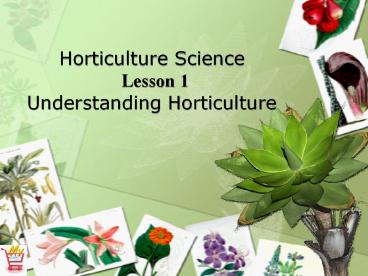Horticulture Science Lesson 1 Understanding Horticulture - PowerPoint PPT Presentation
Title:
Horticulture Science Lesson 1 Understanding Horticulture
Description:
The area of horticulture that involves the production of vegetable food crops is olericulture. Olericulture includes the planting, harvesting, storing, processing, ... – PowerPoint PPT presentation
Number of Views:417
Avg rating:3.0/5.0
Title: Horticulture Science Lesson 1 Understanding Horticulture
1
Horticulture Science Lesson 1Understanding
Horticulture
2
What is horticulture and how does it relate to
science and technology?
- Horticulture is the culture of plants for food,
comfort, and beautification purposes. - In Latin, the term horticulture means garden
culture. - Botany is the major scientific area most closely
related to horticulture. Botany is the study of
plants and their processes.
3
What is horticulture and how does it relate to
science and technology?
- The horticulture industry is the combination of
scientific, technological, and production
activities that ensure the satisfaction of the
consumer.
4
What are the three major segments of the
horticulture industry?
- The horticulture industry can be divided into
three areas ornamental horticulture,
olericulture, and pomology. - Each of these areas is unique and includes many
career opportunities.
5
What are the three major segments of the
horticulture industry?
- The growth and use of plants for their beauty is
the area of horticulture known as ornamental
horticulture. - Ornamental horticulture involves the production
and use of plants used both indoors and outdoors.
6
What are the three major segments of the
horticulture industry?
- Because of the use of green plants, the
ornamental horticulture industry is often
referred to as the green industry. - Examples of crops within ornamental horticulture
are poinsettias, red maple trees, carnations,
forsythia shrubs, and petunias.
7
What are the three major segments of the
horticulture industry?
- The area of horticulture that involves the
production of vegetable food crops is
olericulture. - Olericulture includes the planting, harvesting,
storing, processing, and marketing of vegetable
crops. - Sweet corn, tomatoes, and lettuce are examples of
vegetable crops.
8
What are the three major segments of the
horticulture industry?
- Another food crop production area of horticulture
is pomology. - Pomology is the planting, harvesting, storing,
processing, and marketing of fruit and nut crops. - Examples of fruit and nut crops include peaches,
strawberries, and walnuts.
9
How do the segments of the ornamental
horticulture industrydiffer?
- Ornamental horticulture, one of the three major
areas of the horticulture industry, can itself be
divided into two categories. - These are floriculture and landscape
horticulture. - Both involve the use of flowering and foliage
plants. - Foliage plants are those used for their colorful
greenery or leaves.
10
How do the segments of the ornamental
horticulture industrydiffer?
- Floriculture is the area of horticulture
associated with cut flowers, potted plants, and
annual bedding plants. - Producing, transporting, and using flowering and
foliage plants is known as floriculture. - Poinsettias, carnations, philodendrons, and
petunias are names of common plants associated
with floriculture.
11
How do the segments of the ornamental
horticulture industrydiffer?
- The production and use of plants to beautify the
outdoor environment is landscape horticulture. - Landscape horticulture includes designing plans
for landscapes, installing landscapes as
specified in the plans, and maintaining the
landscapes.
12
How do the segments of the ornamental
horticulture industrydiffer?
- A nursery is a place that specializes in starting
plants and growing them until they are ready to
be transplanted to landscapes. - Nurseries produce groundcover plants, herbaceous
perennials, flowering shrubs, evergreens,
deciduous shade trees, and ornamental trees for
retail and wholesale sales. - Other nurseries, sometimes called sod farms, grow
grass that is moved to landscape projects.
13
How do the segments of the ornamental
horticulture industrydiffer?
- Garden centers are retail outlets that sell
plants grown in nurseries, along with garden
supplies. - Garden centers frequently have a greenhouse range
and floral services.
14
How do the segments of the ornamental
horticulture industrydiffer?
- Arboriculture is a segment of the horticulture
industry that deals with the care of trees. - Some technical skills required of an arborist
include planting, pruning, fertilizing, and
diagnosing and treating diseases and pest
infestations.






























